Appy genetics question...
Forums
Re: Appy genetics question...
Let me see if I got this right.
Lp turns that particular pattern group on and off.
There is something we call PATN1 that can cause the maximum expression of Lp resulting in leopard.
There are also many other PATN genes that "want" other expressions of Lp.
So would it be more like:
Lplp PATN1patn1 PATN2PATN2 PATN3patn3 patn4patn4 (just an example)
or are the PATNs thought to be on the same spot, like the different agoutis? To be additive they'd have to be at different spots... right?
Re: Appy genetics question...
Even if there were different genes involved (and I do not think there are, I think it is more like Sabino) there is no reason why the stallion could not carry every single Appy pattern known to man!!
As I said, my friends Leopard has Blanket, which is only evident when she is clipped to the skin.
*[size=85]PS, is she gone, is it safe to come out now??[/size]*
Re: Appy genetics question...
My leopard has had solids, characteristics only, leopards, and spotted blanket (out of a non app mare).
The latter was born last month, and I will say it surprised me, just like the twins surprised ACC. Guess you just never know!
I know of a fewspot (or maybe he's a large snowcap) POA stallion. Most of his foals are large (to the withers or even alittle beyond) spotted blankets. For the rest, some have just frosting on the hips, some have small blankets, and some are leopards. All these out of non-app mares.
Re: Appy genetics question...
On hotlinking...As stated in the rules I'm asking you not to hotlink (unless you have permission to do so). If you do choose to hotlink you alone will be responsible for any legal implications.
If you are posting the photos under the free use guidlines that is all well and good but that still requires you to give credit. Most of this could probably be completly avoided by simply adding a link back to the website along with the photo. I know if they were my photos I would want a link to my website posted along with the photos.
Re: Appy genetics question...
[quote="Third Peppermint"]Yeah, I understand the mechanism behind fraternal/identical twins and how you can have two pop out that look completely different (which is why I threw the human example in there).
I guess the point that I'm trying to make is that twins being similar/same is a stereotype or a schema that people have in their heads. When you think "twins" you generally don't pick two different things. Despite the fact that all the twins I know (fraternal) are very different looking, I still think of twinned things as two similar objects paired.
So, it's natural to see two twins that look so different and be amazed, despite the fact that it is so common. It's not in our schema of twins. And yes, if they were born a year apart no one would bat an eye. It's just cool seeing twins like that.
Anyway, I guess that's not reeeeally what this thread is about... I am curious about this Lp research that has been done because, frankly, I still don't understand Lp. Am I to understand that the stallion can have BOTH patterns? At the same time? Would that make it so each level of expression was a different gene/set of genes? Are all of the PATNs shared at one locus, or are there many? Also, is what AppyLady said about not getting certain color/pattern markings from full siblings a possibility of gene linking? /toomanyquestionssorry[/quote]
Ya - I agree - very interesting! And I don't pretend to understand Appy genetics at all!
Re: Appy genetics question...
[quote="AppyLady"]ACC, there really isn't anything known as Patn2 at this point. Patn1 (leopard) is most likely caused by a single gene, but the blanket patterns are probably caused by a number of pattern helping genes. The more the horse has, the larger the blanket.
I still don't get this whole "false leopard" thing. LOL! If a leopard has any base color on it's head and neck, it's going to roan out (and usually reveal spots underneath). It's just what Appaloosas do! To say "Appaloosa roan" is actually rather redundant. The only reason that full leopards don't roan is because they don't have any base coat color to roan -- it's already white.[/quote]
I'd have to go digging for examples (and frankly, I'm not in the mood! :rofl ) but I'm pretty sure that not all near leopards roan out to full leopard. Near leopards are believed to have a suppression factor thingy going on (and yeah, I'm not necessarily in the mood to go searching for the right terms! :angle ) which prevents the full expression to occur.
Diane
Re: Appy genetics question...
[quote="lillith"]Have I missed something?
http://www.uky.edu/Ag/Horsemap/hgpfaq4…" onclick="window.open(this.href);return false;
[quote]Likewise, the gene for appaloosa has been found but there are at least 10 different types of white appaloosa patterns. The next frontier in color genetics is to understand what underlies these more subtle influences on color.[/quote]
Have they located LP?[/quote]
Not that I'm 100% sure...from memory, the chromosome has been located, but which gene on that chromosome is being a bigger PITA.
Diane
Re: Appy genetics question...
[quote="Third Peppermint"]I think it's just stunning to see how different twins can look. I like the examples of human mothers giving birth to babies of different skin color. Not impossible (obviously), but unexpected for sure! http://bodyodd.msnbc.msn.com/_news/2008…" onclick="window.open(this.href);return false;
How much do we KNOW about Lp right now? Like, 100% for sure know?[/quote]
Aside from Lp, do we know how equine twinning actually works? How many equine twins are the result of an embryo fully splitting in two, thus creating identical twins, compared to the number of mulitple ovum being fertilised, thus creating fraternal twins? Fraternal twins have different genetics, so two different appaloosa patterns makes a lot more sense.
Diane
Re: Appy genetics question...
[quote="Third Peppermint"]... I am curious about this Lp research that has been done because, frankly, I still don't understand Lp. Am I to understand that the stallion can have BOTH patterns? At the same time? Would that make it so each level of expression was a different gene/set of genes? Are all of the PATNs shared at one locus, or are there many? Also, is what AppyLady said about not getting certain color/pattern markings from full siblings a possibility of gene linking? /toomanyquestionssorry[/quote]
The full expression of Lp is being shown to be polygenetic...you need to have Lp and you need to have what's been dubbed Patn. Think of Lp as being the wiring that brings the electricity into your home. Patn are the lightbulbs that light up your home, using the electricty.
Further on this theme, you only need one type of wiring to bring the electricity in (Lp), but you can have multiple types of lightbulbs...different wattages, different sizes, different "colours" (bright, cool, warm, etc.). If you have the wiring and one little low wattage bulb, you get dim lighting (low level of expression). The bigger the "bulb" the brighter the room and the more you can see. However, you don't need a bigger bulb, you can also lighten the room with using lots of little bulbs, or a variety of different types of bulbs--these will let you see the same as if there was one big bulb.
Does that help any?
Diane
Re: Appy genetics question...
[quote="NZ Appaloosas"]I'd have to go digging for examples (and frankly, I'm not in the mood! :rofl ) but I'm pretty sure that not all near leopards roan out to full leopard. Near leopards are believed to have a suppression factor thingy going on (and yeah, I'm not necessarily in the mood to go searching for the right terms! :angle ) which prevents the full expression to occur.
Diane[/quote]
You're absolutely right, not all near leopards roan out to be full leopards. I could show you examples from my own herd, but I'm not in the mood to go digging for pictures either! But they did show a bit of roaning, even if it wasn't enough to be called a leopard. It would be pretty hard to find an Appaloosa (with LP) that didn't show ANY roaning, even if it was only a few white hairs on the face.
I guess the point I was trying to make was that a near leopard that roans out to be a full leopard is still a real leopard and not a "false" leopard. The leopard genetics are still there.
Re: Appy genetics question...
[quote="Third Peppermint"]
So would it be more like:
Lplp PATN1patn1 PATN2PATN2 PATN3patn3 patn4patn4 (just an example)
[/quote]
That seems to be the current theory...but some of those "Patns" could be things like splash or sabino, which could be giving a boost...like putting a little lamp on the floor vs. putting that lamp on a table.
Diane
Re: Appy genetics question...
[quote="AppyLady"]
I guess the point I was trying to make was that a near leopard that roans out to be a full leopard is still a real leopard and not a "false" leopard. The leopard genetics are still there.[/quote]
Agreed! There is a definite difference between a false and a near leopard. [size=50]And I'm glad I'm not the only one not in the mood to go digging! Two days of sunshine in 2 weeks of rain, now entering the third is insufficient motivation for much of anything.[/size]
Diane
Re: Appy genetics question...
[quote="NZ Appaloosas"]
Does that help any?
[/quote]
Yes. My last (hopefully) question is: Do appies have two lightbulb sockets or are there many sockets?
Like, can they get a 100 watt bulb and a 0 watt bulb and end up bright (because of the 100 watt being all they need to make them fully lit) AND also end up lit with two 50 watt bulbs? Or is this a case of we have 6 or so sockets and can have any random wattages of bulbs based off the parents bulb wattage genes and they all add up?
Re: Appy genetics question...
[quote="AppyLady"]Interesting example with the light bulbs![/quote]
It's grown over the years from being electric wiring and just one light bulb :rofl It sprung from Rebecca and Sheila using a cat in a barn as an example--Lp is the cat, and Patn is the torch that lets you see the cat.
Diane
Re: Appy genetics question...
[quote="Third Peppermint"][quote="NZ Appaloosas"]
Does that help any?
[/quote]
Yes. My last (hopefully) question is: Do appies have two lightbulb sockets or are there many sockets?
Like, can they get a 100 watt bulb and a 0 watt bulb and end up bright (because of the 100 watt being all they need to make them fully lit) AND also end up lit with two 50 watt bulbs? Or is this a case of we have 6 or so sockets and can have any random wattages of bulbs based off the parents bulb wattage genes and they all add up?[/quote]
I would imagine many sockets...there's already "signs" phenotypically, that pattern expression can be assisted thru' other white patterning genes, such as sabino, thru' the observation of false-snowcaps and false fewspots (different from false leopards...false snowcaps/fewspots only look to have two Lp copies, when in reality they only have 1 copy--pedigree analysis has helped shown this).
Diane
Re: Appy genetics question...
I was trying to wrap my head around the whole light bulb thing.. anyway I was thinking about all patterns. Wouldn't even tobiano, sabino etc horses have like a blue print of where the white goes, and they need the tobiano or sabino or whatever gene to make the white show up?? I'm not sure how the appy theory is different?
Re: Appy genetics question...
[quote="accphotography"]FWIW, based on everything I have read, there has NEVER been a set of proven identical twins in horses.[/quote]
I heard that if two fraternal twin embryos in a horse are too close together one or both die or get absorbed or whatever. I wonder if that's why they don't do identicals? Maybe they end up too close together? It's weird that I never noticed that before...
Re: Appy genetics question...
That would make a lot of sense, Third Peppermint. Identical twins share a single placenta. It works in humans because of the discoid placental attachment. I don't think it would be possible for identical foals as one placenta would not likely be sufficient to provide for two foals.
Re: Appy genetics question...
[quote="Danni"]I was trying to wrap my head around the whole light bulb thing.. anyway I was thinking about all patterns. Wouldn't even tobiano, sabino etc horses have like a blue print of where the white goes, and they need the tobiano or sabino or whatever gene to make the white show up?? I'm not sure how the appy theory is different?[/quote]
Actually, if you look at the examples that have crossed this board of solid horses that have tested positive for frame and tobi, it makes sense that they are polygenetic in nature as well. However, I believe that the massive array of expression in appies that just "doesn't make sense" in the normal scheme of things (i.e., blanket + solid = "near leopard") that got people thinking about "Patn".
Diane
Re: Appy genetics question...
[quote="NZ Appaloosas"][quote="AppyLady"]
I guess the point I was trying to make was that a near leopard that roans out to be a full leopard is still a real leopard and not a "false" leopard. The leopard genetics are still there.[/quote][/quote]
I do not think a near Leopard that roans out becomes a Leopard, not at all.
Nothing in the [i]colour[/i] changes the pattern.
A Near Leopard is a Near Leopard, irrespective of what it looks like as a mature animal.
Re: Appy genetics question...
Wow,
I found this thread and thought it would be interesting and well, it was but on more than one level. Geez guys. lol.
Anyway, it's still very interesting and before I share a pic of my own appy colt I want to state here that anyone can use any photo from my website or anything I post here. I think it is beyond stupid to not allow it. Why does anyone put up a website anyway? To draw people in and you have all sorts of viewers and people can copy and enjoy my photo's Anytime. I take them to Share.
Back on track, regarding breeding non-appaloosa to appaloosa and getting spots......wow was I surprised when my solid black, not a white hair on her, registered MFT mare standing there with this wildly marked up appaloosa colt at her side! I believe there are things that non-appy horses have (genes) that can light up the appy gene in a foal and some that will hold it back. Then, there was someone on the AK Arabian group that pointed out to me that there used to be a thought that colts are more loudly colored than fillies. I didn't notice if the twins were both the same sex or different, anyone know??
This photo I've posted is of my colt at a couple hours old and all dried off but still really unsteady. His dam is Million Dollar Lady (MFT) and sire is my stallion, Lil Champagne Tease (grade pony stallion of miniature horse parents) His color is amber champagne appaloosa. All of his foals out of my homozygous appy pony mare are homozygous. His filly out of a different MFT mare is a black sabino. That mare is a sorrel sabino with a lot of sabino roan, 4 socks, lots of sabino splashes and a big blaze but this filly didn't get a single appy characteristic. I wonder if she will carry a PATN gene till she is bred to an LP appy and light up her foal?
Here is the (yet unnamned) colt. My colt, and I am the photographer...... passi it around if you want ;)
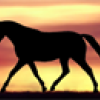
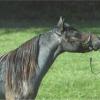




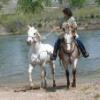
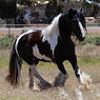

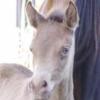
Re: Appy genetics question...
I don't have any trouble believing the differences between twins. One horse can be frame and be entirely solid and another can be frame and be all white. That's a bit different than twins varying to that extreme, but I still 100% believe it's possible. This post was not created to discuss varying ranges of expression within ONE gene, I created it because I believed that separate genes were responsible for the leopard and blanket patterns. I guess a case could be made for the sire carrying both genes or the dam hiding a blanket gene... or I guess some people believe there is no evidence there is another gene besides PATN1 (I personally don't buy that, but there's no proof either way). Don't get me wrong, I understand what you're trying to say, I'm just trying to explain the reason I found it interesting. :)